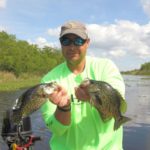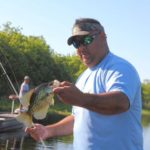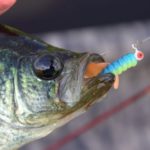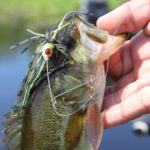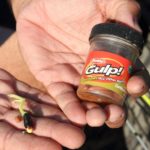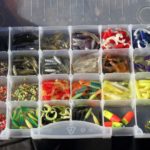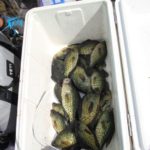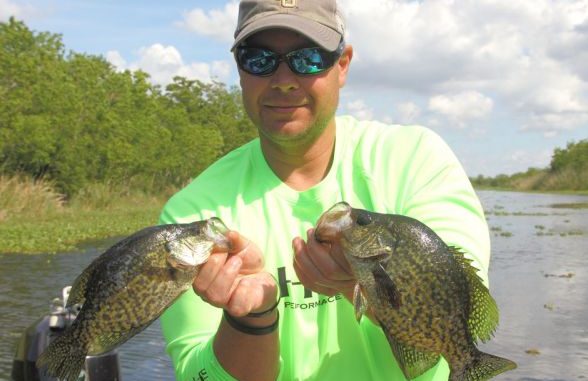
Bass, bream, sac-a-lait make for hot fishing in the summer
Clint Ward dropped his 1/32nd ounce jig into the water. Attached to it was a multi-colored curly tail plastic, tipped with a little piece of Berkley Gulp Earthworm the size of a small snow pea added for enticement. Nowhere in his rigging was a float. What’s more, the lack of a cork gave me pause mainly because I was accustomed to using one where panfish are concerned.
Nonetheless, imagine a place where you can catch five species of fish that includes largemouth, sac-a-lait, goggle eye (warmouth), chinquapin (redear sunfish) and bluegill in abundance on the same outing. Further, a place where the fishing gets better with the approaching dog days of summer.
Not many anglers can say they know a place like that, but they do exist in the Sportsman’s Paradise. Moreover, Ward and I happened to be fishing one of those locations that offered this kind of opportunity.
Located in southwest Louisiana in Cameron Parish, below the Intracoastal Canal, is a region of marshland known to the locals simply as “the Big Burns.” The owner of the land, the Miami Corporation, makes the property available to the general public from mid-March through mid-August each year for about the price of a single round of golf.
The Big Burns is one of those sleeper places where fish are caught with regularity that few anglers in other parts of the state hear about. For one, it’s well off the beaten path. It isn’t a place where someone from Alexandria, Baton Rouge, Lafayette, Monroe, New Orleans, or Shreveport is going to hook up his boat, make a 3 or 4 hour drive to, and be home by mid-afternoon to clean his fish. Someone from well outside the region would have to plan ahead. But rest assured, it would be worth it.
Ward filled me in on what to expect saying that the Big Burns is an extensive marsh with plenty of open shallow bodies of water, lots of lily pads, and submerged aquatic grasses. The open bodies of water range in depth from approximately 6 inches to a couple feet. Ward also said the Big Burns contained quite a number of canals and ditches that run approximately 6 feet in depth.
It was in one of those canals where we started out fishing for sac-a-lait just as the sun spread its light over the horizon. The sun’s rays gave the dew-laden marsh grasses a glow along their leaf edges. You’ll find the Big Burns to be quite enchanting, too.
Seconds hadn’t gone by before Ward’s lightweight rod bent over. For the next several hours we were catching fish. The Big Burns is like a little piece of Cajun heaven.
Ward’s no-float tactic was deadly on the fish we were catching in the canal.
“You’ll see boats out here, where guys are using corks,” Ward explained, “but I find the fish prefer the fall [of the bait]. They really-really like the way the bait falls in these deeper canals. The 1/32nd ounce jig with a plastic tube jig and no cork falls slowly. If it hits the bottom without a bite, you just bounce it a couple times. I like trying this technique first, but like everything, there’s a time and place for it. But, you’ll definitely get your bites here in the Big Burns using it.”
Ward also prefers using ultralight fishing tackle loaded with 6-pound test braided line, with a fluorocarbon leader attached to the braid.
“Some people use braided line all the way down to the lure. But, I find the fish are spooked by it and have seen it where they couldn’t catch, because the fish know that it’s not natural. They won’t eat it,” Ward said. “So, I always use a fluorocarbon leader, because of its invisibility in the water.”
Color-wise, Ward carries the full spectrum when it comes to plastics for panfish. All across the Gulf South, including the Big Burns, the go-to colors tend to be black and chartreuse, blue and white, red and chartreuse, and red and white. Multi-color (blue, orange, yellow) plastics also work well Ward says. During our trip, we also used a few multi-colored plastics with curly tails.
Most anglers who fish the Big Burns are mainly trolling and casting for sac-a-lait. However, with the abundance of other sunfish species, you’re hard pressed to keep these other gamefish off your line.
On our outing, we also wanted to target one other Big Burns fish — the feisty marsh bass. After having caught plenty of sac-a-lait and bream, just to get the full measure of what the area had to offer anglers, Ward suggested we try our hand at catching a few bass.
Ward, in describing the southwest Louisiana bass, said, “There have been reports of 7 pound bass caught in the Big Burns. I had a report of a couple sixes caught and I have pictures on my cell phone of them. They were both native fish. You can look at them and tell, marsh bass are just chunky fish. They’re not lengthy at all like a Florida bass is. But, typically you’re looking at a 12- to 14-inch fish that’ll weigh 1½ to 2 pounds. It’s nothing to come out here on some days and catch a 100 bass. They’re not all going to be keepers, but they’re fun to catch.”
Ward is a 16 year Johnson Bayou, Cameron District firefighter, who grew up in Lake Charles. Besides making a living as a fireman, Ward also plays Cajun music and has shared the stage with Grammy Award winning musician Jo-El Sonnier. He also makes and sells his own bass fishing lures — predominately spinnerbaits. It only made sense for us to give them a try.
For the past several years Clint Ward has been manufacturing his own lures. Those he used to fish the Big Burns, Lacassine National Wildlife Refuge Pool, and other areas around Lake Charles weren’t measuring up to what he felt worked best in the region.
All of his colors match the prey and food sources of the region and are more suitable to the shallow water submerged aquatic plants anglers will come in contact with. Learn more at CW’s Custom Baits Facebook page or, on your way down to the Big Burns stop in at Chesson’s Grocery along LA-27.
We moved out of the canals we were fishing and worked our way to a location with more open shallow water. However, in the southwest marsh, the open water presented its own challenges.
Ward said, “Typically, we have a lot of wind. You’re not fishing a river system and there’s no getting out of the wind in the open marsh. In the summer, there’s a constant southerly wind. When the south breeze blows, it’s hard to fish plastics. So, I’ll use ¼- and 3/8-ounce spinner baits with lots of vibration. They’re something I can control in the wind when I cast. Sometimes with the wind there’s ripples in the water and the sun is shining, making it hard for the bass to see the lure over their head. I find aggressive marsh bass just want to eat, so they hit the spinnerbait really hard.”
Like plastics, spinnerbaits come in every color imaginable. However, Ward says bass obviously target prey that looks like what’s in their environment. One of the colors he prefers is baby bass, developed years ago by Kip Hebert, another lure maker. Ward’s go-to colors for the Big Burns are watermelon green with red sparkle or flakes, chartreuse and white, and junebug with crawfish orange.
The Big Burns is often influenced by weather patterns.
“A north wind pushes a lot of muddy water off the Intracoastal Canal into the main ditches that lead into the Big Burns. Those ditches are your 45 and Superior ditches. The muddy water definitely impacts the fishing. The north wind also blows your water out of the marsh, which makes it a problem navigating, as anyone with an outboard knows,” Ward says. “The water depth in the open marsh already ranges from 6-inches to 2 feet, so lower water, caused by the wind pushing it out, also makes it hard to get up on top while running.”
Ward says a south wind tends to clear the water up. When the wind is blowing out of the south, one of the tactics he likes to use is drifting open flats for bass. While drift-fishing, if the wind is blowing hard, he will throw spinnerbaits. When the wind is calmer, he’ll throw soft plastics around lily pads and the grasses in the open water. Suggested plastics include lizards, Zoom Speed Craws, wacky worms, and Yamamoto Senkos.
Ward also prefers to fish the Big Burns using ultralight tackle. During our trip, Ward brought an assortment of 4’6” to 5’ rods with spinning reels. Each rod was loaded with either 6-pound-test braid, monofilament or fluorocarbon line.
Whether fishing for panfish or bass, using lightweight or medium tackle, live or artificial bait, there are plenty of locations in this region.
Ward said, “There are always places you can go. There’s a lot of plugged ditches, old oilfield locations, and canals throughout the marsh where you can find clear water. The 45 Ditch is very easily accessible and it’s one of the most popular areas to fish. Also, there are early and late bites you have to contend with in the mid-summer months. And, since you can only fish from sunrise to sunset travel comes into play and impacts particularly the late bite.”
The Big Burns does have a few other restrictions. The minimum horsepower on all outboard or surface drive motors allowed is 9.9. And, the maximum horsepower is limited to 25. No kayaks, canoes, pirogues or similar watercraft are allowed, whether powered or unpowered.
Access to the Big Burns is mainly through either side of the Gibbs Town Bridge. On the south side of the bridge after you launch, you’re directly in the Miami Corporation marsh. On the north side, anglers will have approximately a 10 – 15 minute run down the Intracoastal Canal to enter through what the locals refer to as the Superior or 45 Ditch.
According to Amanda Reeves, Public Relations Manager for the Lake Charles/Southwest Louisiana Convention and Visitors Bureau, Miami Corporation increase their number of permits this year to 1,050 due to increased demand. Annual permits cost $40 and allow anglers to bring a guest.
Permits to fish the Big Burns can be purchased in Lake Charles at Lake Charles Tackle, Cajun Tackle, and Gaspard’s Fast Stop. They also can be purchased at Chesson’s Grocery in Bell City.
There are numerous message boards online that pass along up to the minute what’s happening on the Big Burns. But, it doesn’t hurt to stop in or call someone like Hunter Terrell, owner and operator of Lake Charles Tackle.
There are various stories as to how the Big Burns got its name. One local said the Miami Corporation land had a huge fire in the late 1930s as a result of lighting. The region had been experiencing a severe drought and the fire impacted the environment leaving large deep holes where lakes and ponds were formed.
Still others say it is because it is so large and is burned each year as habitat management.
Whatever the case, one thing is sure. There is plenty of hot action on the Big Burns each year. If you’re fortunate to obtain a permit or go as a guest with someone consider yourself lucky.
